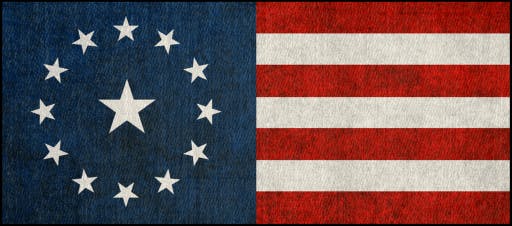
That the flag of the United States shall be of thirteen stripes of alternate red and white, with a union of thirteen stars of white in a blue field, representing the new constellation.
The vibrant hues of red and white adorning the American flag encapsulate layers of symbolic significance deeply ingrained in the nation's history and values. The bold red stripes symbolize valor and bravery, echoing the indomitable spirit of those who have fearlessly defended liberty and justice throughout America's journey. This hue serves as a testament to the resilience of the American people, embodying their unwavering courage in the face of adversity. Each crimson stripe stands as a tribute to the sacrifices made by generations past and present in the pursuit of freedom and equality. Contrasting against this fiery backdrop, the pristine white stripes evoke purity and innocence, representing the nation's commitment to truth and righteousness. These alternating stripes of red and white form a harmonious tapestry, reflecting the diversity and unity that define the American identity. Together, they weave a narrative of perseverance, aspiration, and shared values that unite the nation under the banner of hope and opportunity.
The color blue on the American flag holds profound symbolism, embodying the enduring principles of vigilance, perseverance, and justice that underpin the nation's foundation. Stretching across the canton, or union, the deep blue field signifies the valor and sacrifice of those who have served and continue to serve in the defense of freedom. It serves as a steadfast reminder of the nation's commitment to safeguarding liberty and upholding the rule of law. Moreover, the blue field was originally adorned with a constellation of thirteen stars, each representing each of the original states in the union, fostering a sense of unity and shared purpose among diverse peoples and communities. As the backdrop to these stars, the blue field serves as a beacon of hope and resilience, guiding the nation forward through challenges and triumphs alike. It symbolizes the vast expanse of possibilities and opportunities afforded by America, inviting all who gaze upon it to envision a brighter future built upon the principles of equality, freedom, and justice for all.
-
On June 14, 1777, the Continental Congress fervently embraced a momentous resolution, an emblematic testament to the burgeoning spirit of a fledgling nation. Stirred by the report of a dedicated special committee, diligently tasked with the weighty responsibility of envisioning a symbol that would encapsulate the essence of their aspirations, this resolution bore witness to the birth of an enduring emblem: the American flag. Crafted with meticulous care and imbued with the hopes and dreams of a burgeoning republic, this flag was more than mere cloth and pigment; it was a beacon of unity, a rallying cry for freedom, and a proclamation of defiance against tyranny. In its stars and stripes danced the promise of a nation forged in the crucible of struggle, bound by the ideals of liberty and justice for all. And so, with unwavering resolve, the Continental Congress enshrined this symbol of unity, etching its indelible mark upon the annals of history, ensuring that the stars and stripes would forever wave as a symbol of the American spirit.
The historic journey of the American flag unfurled with a spirit of defiance and resilience, as it first fluttered proudly in the winds of battle on September 11, 1777, amidst the tumult of the Battle of the Brandywine. Symbolizing the steadfast resolve of a burgeoning nation, this flag of stars and stripes became a beacon of hope amid the chaos of conflict. Its significance transcended borders, as foreign naval vessels paid homage to its symbolism on February 14, 1778, in a stirring salute to the Stars and Stripes upon the arrival of the Ranger, helmed by the intrepid Captain Paul Jones, in a French port. This momentous occasion marked a testament to the enduring bonds of camaraderie and shared ideals that spanned oceans. As the flag fluttered over foreign terrain for the first time in early 1778 at Nassau, Bahama Islands, following the capture of a British fort by American forces, its presence resonated with the echoes of liberty and independence. In each of these pivotal moments, the American flag stood as a symbol of courage, resilience, and the unyielding spirit of a nation forging its destiny amidst the turbulence of history.
While the adoption of the flag on June 14, 1777, marked a pivotal moment in American history, the formal recognition and observance of Flag Day did not swiftly follow suit. Despite numerous claims purporting to be the inaugural official observance of this significant day, the reality is that nearly a century had elapsed before any formal acknowledgment took place. The passage of time, with its myriad of events and shifting priorities, seemingly relegated Flag Day to the annals of overlooked commemorations. Yet, amidst this historical oversight, the enduring symbolism of the American flag persisted, woven into the fabric of the nation's identity and collective memory. It wasn't until well into the 19th and 20th centuries that efforts to formally recognize Flag Day gained momentum, propelled by a growing sense of national pride and the desire to honor the emblem that had come to represent the ideals and aspirations of the American people. Thus, while the official observance of Flag Day may have been delayed, its significance endured, serving as a powerful reminder of the enduring legacy of the Stars and Stripes.
The initial assertion of a Flag Day celebration dates back to a Hartford, Connecticut event in the inaugural summer of 1861, a time of tumult and upheaval in American history as the nation grappled with the throes of the Civil War. However, it wasn't until the late 1800s that the concept of Flag Day gained significant traction, particularly within the realm of education. Schools across the United States embraced the notion of holding Flag Day programs, viewing them as a means to instill a sense of patriotism and national pride, particularly among immigrant children. Against the backdrop of a rapidly evolving American landscape, these celebrations served as a cornerstone in the process of assimilation and Americanization, aiming to imbue the youth with a deep-seated reverence for the Stars and Stripes and the principles it embodied. Over time, the observance of Flag Day transcended the confines of the classroom, resonating deeply within individual communities across the nation. It became a symbol of unity and solidarity, a day when Americans of all backgrounds could come together to honor the cherished emblem that symbolized their collective identity and shared aspirations. Thus, from its modest beginnings in a Hartford summer to its widespread adoption in schools and communities nationwide, Flag Day emerged as a testament to the enduring power of the American spirit.
The most widely acknowledged claim regarding the origins of Flag Day, however, is rooted in the vibrant streets of New York City. On June 14, 1889, Professor George Bolch, a visionary educator dedicated to uplifting the underprivileged, orchestrated a stirring display of patriotism at a free kindergarten for the impoverished denizens of the city. Recognizing the significance of the anniversary of the Flag Day resolution, Professor Bolch organized a series of patriotic ceremonies within his school, aimed at instilling a profound sense of national pride and unity among his young charges. This bold initiative did not go unnoticed; it garnered the attention of the State Department of Education, which swiftly recognized the importance of such commemorations and took decisive action to institutionalize the observance of Flag Day in all public schools across the state. Thus, from the humble beginnings of a kindergarten in New York City emerged a movement that would reverberate across the educational landscape, firmly cementing Flag Day as a cherished tradition and a cornerstone of American civic education. Through Professor Bolch's pioneering efforts, the spirit of patriotism was kindled anew, ensuring that the legacy of the Stars and Stripes would be honored and celebrated for generations to come.
In a swift and decisive move, the state legislature took proactive measures to enshrine the significance of key national commemorations into law, thereby affirming the foundational values that underpin the American identity. With the passage of legislation mandating the observance of Lincoln’s Birthday, Washington’s Birthday, Memorial Day, and Flag Day, the responsibility for fostering a deep appreciation for these pivotal moments in history fell squarely upon the shoulders of the state superintendent of public schools. This legislative decree signaled a profound commitment to civic education and a recognition of the importance of honoring the legacies of those who shaped the course of the nation. However, it was in the year 1897 that the observance of Flag Day took on a new dimension of official recognition. At the behest of the governor of New York, a directive was issued for the display of the flag atop all public buildings throughout the state. This symbolic gesture, regarded by many as the inaugural official recognition of the anniversary of the adoption of the flag outside of educational institutions, underscored the profound significance of the Stars and Stripes as a unifying emblem of national identity. Through these legislative and gubernatorial actions, the spirit of patriotism was reaffirmed, and the enduring legacy of the American flag was celebrated in grand fashion, casting a beacon of unity and pride across the landscape of the Empire State.
Another intriguing claim to the origins of Flag Day emerges from the storied streets of Philadelphia, steeped in the rich tapestry of American history. In the year 1893, the Society of Colonial Dames achieved a significant milestone by successfully advocating for a resolution mandating the display of the flag on all public buildings throughout the city. Spearheading this initiative was Elizabeth Duane Gillespie, a formidable figure whose lineage traced back to none other than the revered statesman and Founding Father, Benjamin Franklin. As the president of the Colonial Dames of Pennsylvania, Gillespie wielded her influence to champion the cause of patriotism and national pride. Undeterred by the initial lack of attention granted to their efforts, Gillespie and her compatriots pressed on, endeavoring to secure formal recognition for June 14 as Flag Day. However, the resolutions put forth by women, despite their impassioned advocacy, languished in obscurity for decades. It wasn't until May 7, 1937, that the Keystone State of Pennsylvania emerged as a trailblazer, becoming the first state to officially designate June 14 as Flag Day, enshrining it as a legal holiday. While Flag Day has since evolved into a nationwide observance, Pennsylvania stands as a solitary beacon, the sole state to accord it the esteemed status of a legal holiday, a testament to the enduring legacy of those early pioneers who fervently championed the cause of honoring the Stars and Stripes.
In the quiet town of Waubeka, Wisconsin, the indefatigable efforts of Bernard J. Cigrand, a dedicated schoolteacher, echoed through the corridors of history as he tirelessly advocated for the recognition of June 14 as a national holiday. For years, Cigrand fervently implored Congress to bestow upon this date the esteemed status it deserved, a testament to the enduring significance of the American flag. Though his impassioned appeals failed to sway the halls of power, June 14 was nevertheless embraced by communities far and wide, as a day of reverence and reflection upon the cherished emblem of the nation. Cigrand's unwavering commitment to this cause earned him the moniker of the "Father of Flag Day," a title bestowed upon him in recognition of his tireless advocacy and unwavering devotion to the principles symbolized by the Stars and Stripes. Yet, amidst Cigrand's noble endeavors, another figure emerges from the annals of history, William T. Kerr, a schoolboy from Pittsburgh, Pennsylvania, whose youthful zeal sparked the founding of the American Flag Day Association in 1888. Despite his tender age, Kerr's vision and dedication laid the groundwork for the widespread observance of Flag Day, casting a ripple of patriotic fervor that would resonate across the nation. Thus, through the combined efforts of Cigrand and Kerr, the legacy of Flag Day was firmly established, a testament to the enduring power of civic engagement and the timeless symbolism of the American flag.
The journey towards formal recognition of June 14 as National Flag Day bore witness to the steadfast commitment of successive presidents to honor the enduring symbol of American unity and resilience. In 1916, President Woodrow Wilson set the stage by issuing a proclamation urging the nation to observe June 14 as National Flag Day, recognizing the significance of this date in commemorating the adoption of the Stars and Stripes. Over a decade later, in 1927, President Calvin Coolidge echoed Wilson's sentiments, reaffirming the call for the nationwide observance of Flag Day. However, it wasn't until August 3, 1949, that Congress finally took decisive action, passing legislation to officially designate June 14 as National Flag Day. With the stroke of a pen, President Harry Truman solidified this momentous occasion, signing the bill into law and enshrining Flag Day as a cherished national observance. This historic milestone served as a testament to the enduring reverence and respect accorded to the American flag, embodying the principles of freedom, liberty, and unity that lie at the heart of the nation's identity. Through the combined efforts of presidents, lawmakers, and all Americans alike, Flag Day emerged as a solemn occasion to reflect upon the sacrifices of generations past and reaffirm the enduring values that unite Americans from all walks of life.



